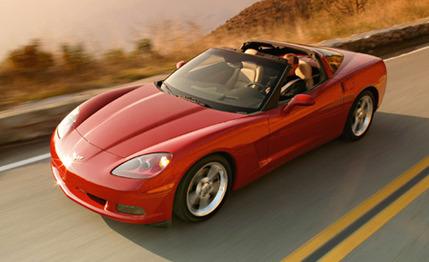
 First Drive Review
First Drive Review
Forget about calling the new Corvette the C6. C6 is something you are afflicted with on a rough sea passage.
Besides, the 2005 Corvette that Chevy unveiled at the Detroit show last month, and which goes on sale in targa and convertible forms late this summer, is hardly the beginning of a new generation, as "C6" would imply. Like the '68 Vette, the 2005 is a profound evolution of the existing car. It's one long stride on the road of continual improvement.
The Corvette's technical daddy, Dave Hill, says 70 percent of the parts numbers are new. We frequently go through this with manufacturers. If the suspension control arms look exactly the same but carry a different parts number, are they new?
We'll compromise and say the 2005 Corvette is the C5 and 11/16ths.
Whatever. As Hill puts it, "The more you look, the more you see."
Which is good, because when they pulled the drape off a bright red 2005 at GM headquarters, we were, let's say, underwhelmed. Of course we were looking at it in profile where the least amount of difference is immediately noticeable. The basic C5 forms are all represented here: Big butt. Pointy nose. Tapered canopy greenhouse.
But there's . . . something different here. It looks more purposeful, more potent, and more compact. It's not entirely a trick of styling. The Corvette has shrunk by five inches in length and by an inch in width, measured at its still-ample hips. All that length was taken out of the overhangs: two inches from the front and, mercifully, three off the chunky rump. A strengthened crash structure up front allowed the nose job. Rerouting the exhaust straight out the back and placing the mufflers in an area formerly taken up by a useless spare-tire well (that never carried a spare) allowed designers to chop the rear. The C6's wheelbase is 1.2 inches longer than that of the C5. This pushes the wheels to the corners and makes the overall package appear less massive. Those wheels are also larger in diameter by an inch front and rear (18 inches in front; 19 at the rear), which appears to further shrink the body.
But it's the nose and tail that are the obvious difference here. The size and shape of the C5's tail was determined more by the wind tunnel than aesthetic considerations, and, well, not everything the wind creates is beautiful. The new tail is still a sharp-edged quasi Kammback, but it tapers a bit more between the trailing edge of the rear wheel and the terminus. Viewed in profile, there's a sort-of S-curve contour that brings some visual interest to the formerly billboard-bland expanse of bum.
Even at first glance the nose of the new car might seem familiar-but not with any previous Corvette. The clear-lens-covered high-intensity-discharge headlamps and low center grille might remind you of the Ferrari 575M Maranello. If you stare at the snout long enough, you will see many things, as Hill had promised. One of them might be a Dodge Viper. The look might not scream Corvette, but it is handsome. The folks at team Corvette are more than aware of their car's vaguely cultlike following, and ditching the hidden headlamps (the first Vette since 1962 without them) was the source of no small amount of consternation. The new light housings, though, save "some good little amount of weight," allow for the use of HID lamps, and are not "air brakes," as Hill describes the pop-ups.
Unlike the new Mustang, the Corvette doesn't plagiarize its own past. There's no split rear window as on the '63. No "stinger hood" à la big-block '67s.
But head designer Tom Peters did add a hint of the 1963-67 Sting Ray front and rear fenders. The sharp-edged, tall fenders defined those mid-years Vettes. Think of the 2005's fenders as a version of the C5's fenders but with a good trouser crease running along the tops and slightly into the door panels. Truth is, we didn't even notice them for a few minutes. No surface of the new car has gone untouched, but none looks completely rethought, either.
Underneath the plastic body, the look is even more familiar. The structure, which on the C5 was exemplary for its high stiffness at a relatively light weight, remains the same-hydroformed steel side rails, a tall center tunnel, balsa sandwiches for the floors. Likewise, the cast aluminum upper and lower control arms and transverse composite leaf springs are familiar from the C5 and the Cadillac XLR hardtop roadster.